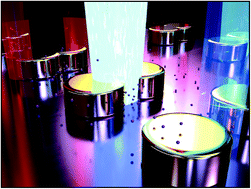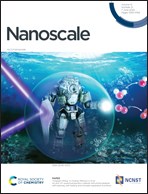Ultra-fine electrochemical tuning of hybridized plasmon modes for ultimate light confinement†
Abstract
Highly reproducible control of metal plasmonic nanostructures has been achieved via precise tuning of the electrochemical Au dissolution reaction that occurs at the surfaces of well-defined bridged nanodisk dimer structures on an atomic scale. It was found that the scattering intensity is strongly suppressed during the transition from the conductive mode to the gap mode of the localized surface plasmon resonance during the period when the gap is formed and increased between Au nanodisks. The characteristic shift of the plasmon mode during this suppression of the scattering intensity verifies the excitation of the bonding quadrupolar mode, which appears only at sub-nanometer gap distances (d < 1 nm). Electrochemical potential control demonstrates that the scattering suppression states with estimated gap distances of less than 1 nm can be maintained for more than 100 s under ambient conditions. The method and phenomena presented here will be useful in the preparation of plasmonic structures for ultimate light confinement applications.



 Please wait while we load your content...
Please wait while we load your content...